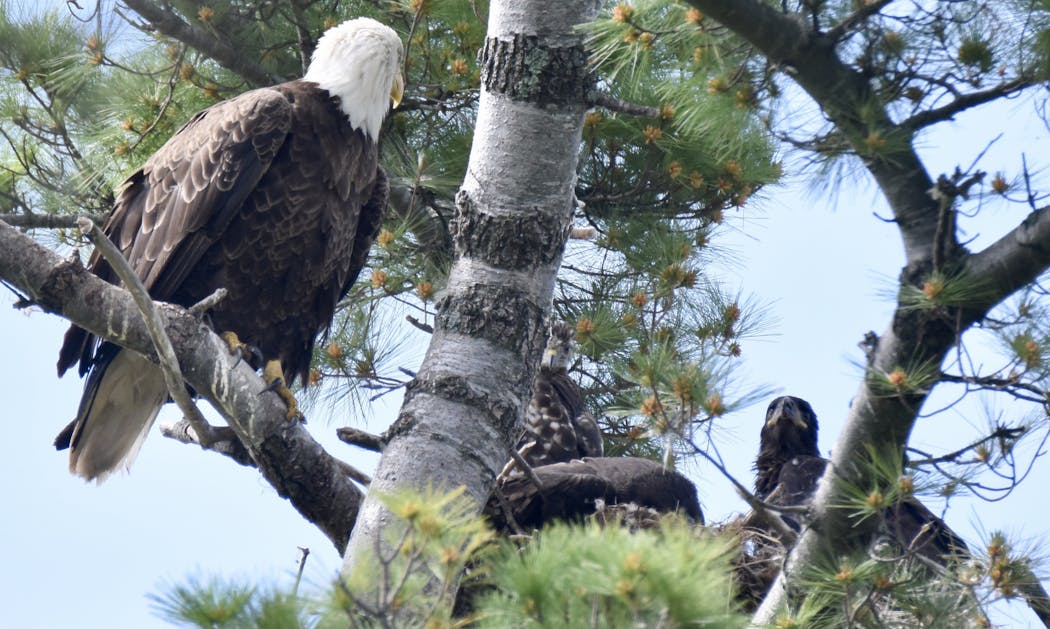We expect to see red-tailed hawks soaring over open country, or perched on a freeway light tower, searching for the rodents that make up much of their diet.
Where we don't expect to see a red-tailed hawk is in a bald eagle's nest. And yet that's exactly the situation in one nest this summer in Door County, Wis.
Linda Rappel, an avid bird photographer, was keeping an eye on an eagle nest when one June day she noticed a much-smaller raptor standing beside two large eagle youngsters. It was a young red-tailed hawk in the nest, and later that day the hawk was perched beside an adult eagle on a branch.
Luckily, she took photos to document this rare happenstance and sent them to me. When I opened up her photo file, I was astonished: What was a red-tailed hawk doing in an eagle nest, and why hadn't the eagles treated the smaller raptor like prey, something to feed their eaglets?
Some internet searching turned up an article about a red-tailed hawk reared by bald eagles in British Columbia in 2018. The experts in the article leaned toward the theory that an eagle parent had raided a red-tailed hawk nest and seized a hawk chick to feed to its own youngsters. But the young hawk somehow evaded being eaten and was instead reared by the eagles.
There have been a few other observations of eagles raising a red-tailed hawk in Western states, so it's not entirely unheard of. I really wanted some answers for this unusual case, so I contacted local experts who know their eagles.
John Moriarty, a wildlife manager for Three Rivers Park District and an eagle watcher for many years, speculated:
"My guess, and it's totally a guess, is that a hawk egg was laid in the eagle nest at the same time that the eagle was laying eggs," noting that this occurs in some other species, like ducks and game birds.
Similarly, Laura Erickson, author of many books and radio shows about birds, doubts the hawk-as-prey scenario:
"I think it's very improbable that an eagle carried a hawk to the nest and then suddenly forgot that it was food. I am much more inclined to believe that the hawk egg was laid in the eagle nest," she noted, adding that birds do often attach to every infant in their nest.
Still, could a young hawk survive on the typical eagle diet of fish and scavenged items like road-killed deer? After all, red-tails are expert rodent hunters and tend to survive on voles, mice and squirrels.
Victoria Hall, executive director of the Raptor Center, and her colleagues align with the hawk-laid-an-egg-in-an-eagle-nest theory.
"Red-tailed hawks and eagles might be close enough that there could be a chance for a happy ending for this youngster," Hall said, "but eagles hunt and eat differently and are going to teach their young these specific skills."
Young raptors need to be raised by their own kind, Hall pointed out, "a huge reason that we always try to get young raptors who fall out of nests back into their nests as quickly as possible," she added.
"Being the 'odd bird out' in a nest unfortunately does not usually end well in the animal world," Hall pointed out.
Will the young Wisconsin red-tail somehow teach itself how to detect and snatch rodents scurrying in a field? After imprinting on eagles, will it recognize another red-tailed hawk as its own kind, and eventually choose a mate, or will it try to court a bald eagle later in life?
As the Raptor Center's Hall says, "Only time will tell the outcome here."
St. Paul resident Val Cunningham, who volunteers with the St. Paul Audubon Society and writes about nature for local, regional and national newspapers and magazines, can be reached at valwrites@comcast.net.

Lose yourself in these new immersive Las Vegas experiences
Streetscapes

Critics' picks: The 12 best things to do and see in the Twin Cities this week




